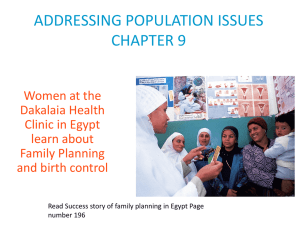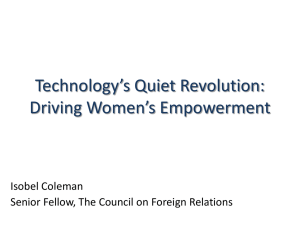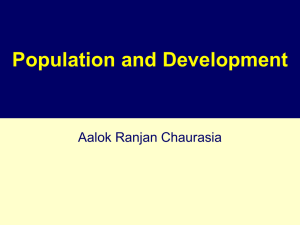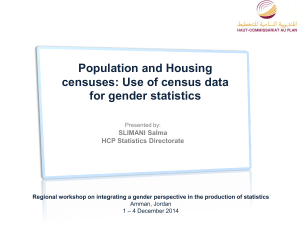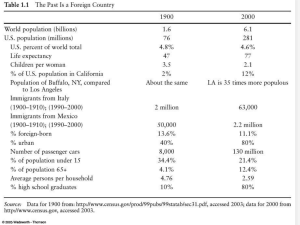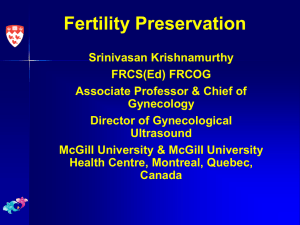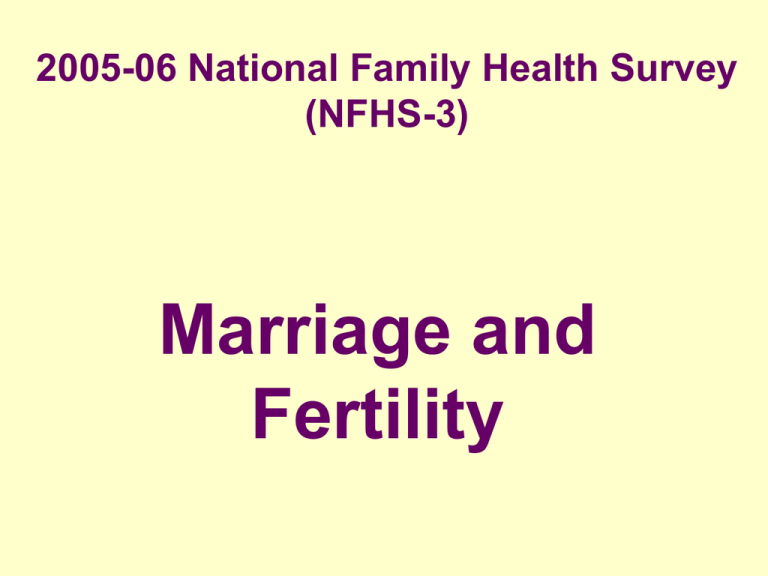
2005-06 National Family Health Survey
(NFHS-3)
Marriage and
Fertility
Levels, trends &
differentials
Determinants of
fertility
Fertility
preferences and
ideal family size
(c) 2001 Hugh Rigby/CCP, Courtesy of Photoshare
NFHS-3, India, 2005-06
At current fertility levels, a woman in
India will have an average of 2.7
children during her lifetime
Urban women have attained replacement
fertility but rural women have on an average
0.9 children more than urban women.
NFHS-3, India, 2005-06
Trends in Fertility by Residence
3.7
3.4
3.1 3.0
2.7
2.3
2.9
2.1
Urban
Rural
NFHS-1
NFHS-2
Total
NFHS-3
2.7
Fertility Differentials and Trend by Caste
and Religion
Muslim fertility is decreasing faster than Hindu fertility;
thus, Hindu-Muslim fertility differentials are narrowing.
Fertility of ST and OBC women has remained unchanged.
NFHS-2
NFHS-3
3.6
3.2
2.9
3.1 3.1
2.8 2.8
2.8
2.7
3.1
2.7
2.4
SC
ST
OBC
Other
Hindu
Muslim
Just a Few Years of Education Leads to
Substantial Reduction in Fertility
TFR of women with
No education – 3.6
< 5 years of education – 2.5
12+ years of education – 1.8
TFR of women from
Lowest wealth quintile - 3.9
Second lowest wealth quintile – 3.2
Highest wealth quintile – 1.8
NFHS-3, India, 2005-06
Total Fertility Rates for States
INDIA
Replacement or
below replacement
(10 states 35%
population)
TFR 2.1 – 2.4
(6 states 20%
population)
TFR 2.5 – 3.6
(9 states 19%
population)
TFR 3.7 – 4.0
(4 states 25%
population)
NFHS-3, India, 2005-06
Fertility Decline in High Fertility States
Between NFHS-2 and NFHS-3 in most of the
states fertility declined.
TFR in NFHS-2 > 3.0
States
TFR increased
TFR remained same
TFR decreased
TFR in NFHS-2 < 3.0,
but increased
Bihar (0.3)
Nagaland
Manipur (0.2), Uttar Pradesh (0.2)
Madhya Pradesh (0.3), Rajasthan
(0.6), Meghalaya (0.8)
Jharkhand (0.6), Arunachal
Pradesh (0.5), Tripura (0.4),
Assam (0.1)
Levels, trends &
differentials
Determinants of
fertility
Fertility
preferences and
ideal family size
(c) 2001 Hugh Rigby/CCP, Courtesy of Photoshare
NFHS-3, India, 2005-06
Though, fertility in the 15-19 age group is
decreasing, still, a substantial proportion of
teenagers have begun childbearing.
12% of women 15-19 are already mothers
4% of women 15-19 are pregnant with their
first child
In total, 16% women 15-19 have begun
childbearing
NFHS-3, India, 2005-06
Teenage Fertility by Age
Percent who are pregnant or already mothers
36
24
13
3
15
6
16
17
18
19
Age
NFHS-3, India, 2005-06
Age at Marriage
Percentage of women age 20-24 married by age 18
54
53
50
45
28
NFHS-1
NFHS-2
NFHS-3 Total
NFHS-3 Urban
NFHS-3 Rural
NFHS-3, India, 2005-06
Initiation of Childbearing
Median age at first birth for women age 25-49:
19.8 (Total)
20.9 (Urban)
19.3 (Rural)
Median age at first birth increased
by half a year from 19.3 in NFHS-2
NFHS-3, India, 2005-06
State-Level Variation in Early Marriage of
Women and Teenage Fertility
Percentage of
women age
20-24 married
by age 18
States
Less than
15%
Goa, Himachal
Pradesh, Jammu
& Kashmir
55% or more
Jharkhand (61%),
Bihar (60%),
Rajasthan (57%) ,
Andhra Pradesh
(55%)
Women age 15-19
already mothers
or pregnant at
time of survey
(%)
States
5% or less
Goa, Himachal
Pradesh, Jammu
& Kashmir, Delhi
25% or more
Jharkhand
(28%), Bihar
(25%), West
Bengal (25%)
NFHS-3, India, 2005-06
In most states, the proportion of women
marrying by age 18 is decreasing and
median age at first birth is increasing, but
in a few states, the reverse is happening.
Since NFHS-2,
In Arunachal Pradesh, Punjab, Mizoram, Sikkim,
Tripura and West Bengal, the percentage of women
age 20-24 married by age 18 has increased; and
In Arunachal Pradesh, Punjab, Mizoram, and West
Bengal, the median age at first birth has decreased
NFHS-3, India, 2005-06
• In addition to their impact on fertility, birth
intervals may also affect the health of mothers and
their children
• Birth intervals are also strongly associated with
child mortality:
Children born too close to a previous birth are
at increased risk of health problems and of
dying at an early age
NFHS-3, India, 2005-06
Length of Birth Intervals
61% of non-first
births
occur less than
36 months
after the
preceding birth
7-17
months
11%
18-23
months
16%
24-35
months
34%
60+
months
36-47
48-59
10%
months
months
19%
9%
NFHS-3, India, 2005-06
Levels, trends &
differentials
Determinants of
fertility
Fertility
preferences and
ideal family size
(c) 2001 Hugh Rigby/CCP, Courtesy of Photoshare
NFHS-3, India, 2005-06
Ideal Family Size and Composition
2.3
0.4
2.9
2.3
2.7
0.2
0.3
0.6
0.4
1.1
0.8
0.7
1.0
Either sex
Daughters
Sons
0.9
1.6
1.1
Women
1.0
Men
All persons
2.5
NFHS-1
1.4
NFHS-2
1.2
NFHS-3
Ever-married women
NFHS-3, India, 2005-06
In the Majority of States, Ideal Family
Size is Below 2.5:
Ideal family size of women and men
2.5 to 2.9:
Rajasthan, Chhattisgarh, Madhya Pradesh,
Uttar Pradesh, Bihar, Jharkhand, Arunachal
Pradesh & Manipur
Ideal family size of women and men 3.0- 3.9
Meghalaya,
Mizoram & Nagaland
NFHS-3, India, 2005-06
Two-Child Family is Becoming a Norm
Proportion of currently married women and men
who want no more children
Women
83 84
Men
90 91
92 94
92 94
3
4
5
89
96
28 27
4
3
0
1
2
6+
Number of living children
NFHS-3, India, 2005-06
Son Preference among Women and Men
Proportion of currently married women and men
having 2 living children and wanting no more children
90
92
87
88
62
61
Women
2 sons
1 son and 1 daughter
Men
2 daughters
NFHS-3, India, 2005-06
Son Preference: Level and Trend
Proportion of currently married women
having 2 living children and wanting no more children
83
72
90
87
76
66
61
47
37
NFHS-1
2 sons
NFHS-2
1 son and 1 daughter
NFHS-3
2 daughters
Son Preference by State
In states with replacement and below
replacement-level fertility, son preference is
low, but exceptions are Punjab and
Maharashtra
In states with TFR between 2.1 and 3 son
preference is lower, but exceptions are
Haryana, Uttaranchal, Jammu & Kashmir,
Orissa, Chhattisgarh, and West Bengal
Desire for No More Children by Number of Children
(States with TFR >3)
Proportion of currently married women
having 2 living children and want no more children
92
85
84
80
77
74
62
46
47
38
33
33
32
27
31
20
ARP
MP
RJ
JH
2 sons
NG
MG
UP
BH
2 daughters
NFHS-3, India, 2005-06
Wanted and Actual Fertility Rates
TFR
Total
1.9
TFR
2.7
0.8
NFHS-3
Urban
1.6
Rural
0.5
2.1
0
1
2
3.0
3
0.8
2.7
Wanted TFR
Unwanted TFR
2.1
0.9
1.9
4
NFHS-2
2.1
0
1
2.9
0.8
2
3
4
If unwanted fertility is averted, TFR
will reach replacement level
NFHS-3, India, 2005-06
Key Findings
The Indian woman, on average, bears 2.7 children
in her lifetime
Urban India has reached replacement-level fertility
Ten states, comprising 35% of India’s population,
have already reached replacement-level fertility; 6
more states with 20% population are nearing
replacement-level fertility
Early initiation of childbearing and shorter spacing
of births are matters of concern
NFHS-3, India, 2005-06
Key Findings, contd.
For most couples, a two-child family is the
norm
Son preference, though reducing, still
persists
Unwanted fertility forms a sizeable part of
actual fertility and averting that is the best
way to achieve replacement fertility
NFHS-3, India, 2005-06
Thank You


